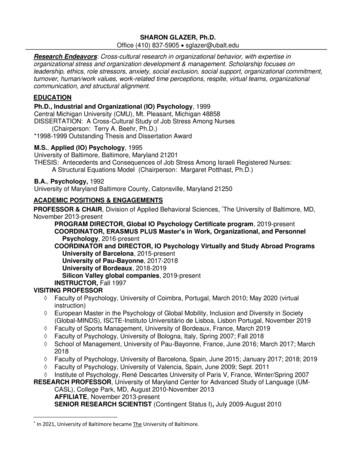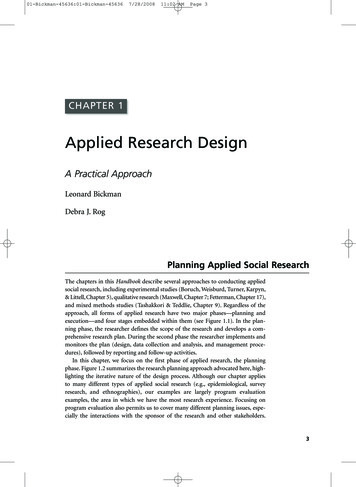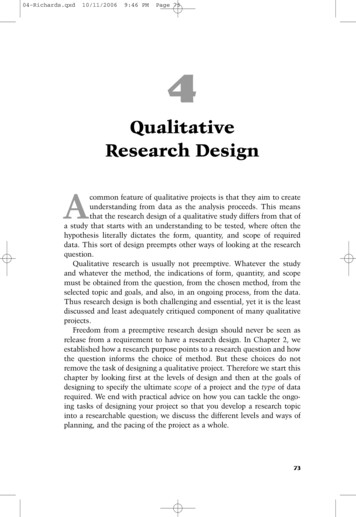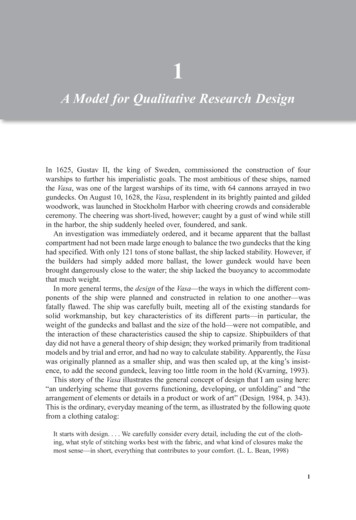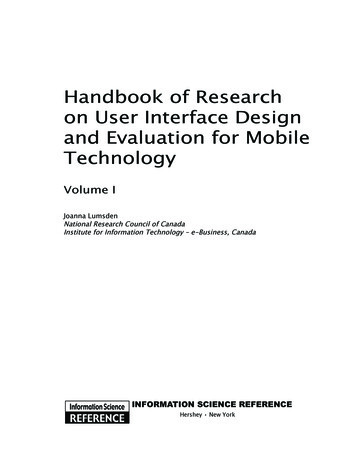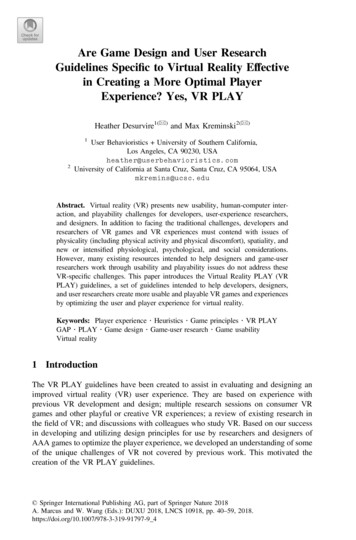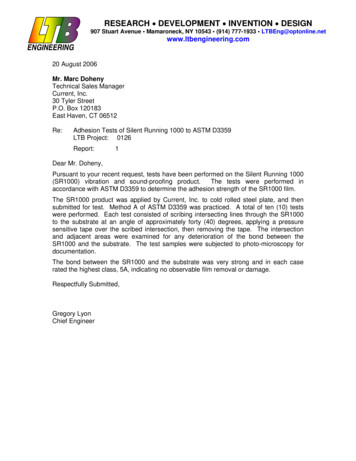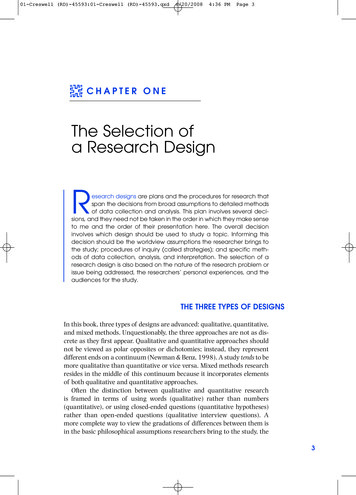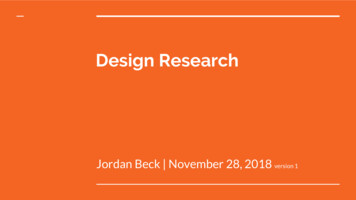
Transcription
Design ResearchJordan Beck November 28, 2018 version 1
Framing“In the HCI and IxD research communitiesthere has been a struggle to figure outhow to integrate design with technologyand behavioral science in support of HCIeducation and research” (Zimmerman, Forlizzi, Evenson, 2007).
key terms/definitionsexamples of design researchStructure role of design in HCI researchevaluation criteriacurrent questions/issuesresources
What are some key definitions?
Design. A process in whichsomething is created -- workingout the form of something new,consciously [intentionally]creating something that was notthere before.(Nelson Stolterman, 2003)
Design Research.An inquiry focused onproducing a contribution ofknowledge rather than on thedevelopment of a product(Zimmerman, Forlizzi, Evenson, 2007).
RtD involves designingsomething (e.g. an artifact orsystem) as key componentof your inquiry.
“Research is the pointand design is the meansto do it”(Fallman, 2008)Design-oriented Research
What are some examples of RtD?
(early stage) Mendeley Mobile (Beck.) Dive (Beck, Chakravarty, Wattis) Philosophers Living with theTilting Bowl (Wakkary et al. 2018) TaskCam (Boucher et al, 2018)(late stage)
Mendeley Mobile(Beck, 2018)
Dive(Beck, Chakravarty, & Wattis, 2018)
Tilting Bowl(Wakkary et al., 2018)
TaskCam(Boucher et al., 2018)
A design is somethingreal that helpsresearchers determinesomething true.
Design should be integrated into aresearch project as soon as possible.
What do designers add toresearch projects?
One. Attention toproblem setting.
Theory-Practice Gap (Beck & Ekbia, 2018)Problems are artificial.
Two. Pattern languages.
Pattern LanguagesGive regular, intelligible form to design principles, guidelines,qualities, .
Three.Attentionto criticalissues.
Example 1: Drift TableWilliam W. Gaver, John Bowers, Andrew Boucher, Hans Gellerson, Sarah Pennington, Albrecht Schmidt, Anthony Steed, Nicholas Villars, and Brendan Walker. 2004. The drift table:designing for ludic engagement. In CHI '04 Extended Abstracts on Human Factors in Computing Systems (CHI EA '04). ACM, New York, NY, USA, 885-900. DOI:https://doi.org/10.1145/985921.985947
Designs articulate/embody critical questions.“Menstruation Machine” by Sputniko!Image: /designandviolence/menstruation-machine-sputniko/
Designs facilitate data collection
Direct Collection. The designcaptures and stores data.
Indirect Collection. The designsupports interviews, , .
Designs help communicatecontributions.
Designs envisionfutures, and, thus,raise questions andidentify possibleresearch directions.
Design Fiction“[stories or scenarios in which] the imaginarytechnologies are plausible and the social and politicalcontext for the new technologies is imagined in depthand detail.” (Sterling via Blythe, 2017).“Design fiction creates imaginative conversationsabout possible future worlds it speculates about anear future tomorrow, by extrapolating from today”(Bleeker, 2009)Even artifacts tell [ambiguous] stories (Blythe, 2017)
Computer Vision Scenario(developed in thecenter for HCI @ Penn State University)Kelly receives a notification from her phone to take a new medicine she was recently prescribed. As she goesto get the medicine bottle, she worries about selecting the right bottle and making sure she has the right timeand dosage - she takes quite a few medicines now and is not yet confident about this new one. She calls Airaand asks the agent, Tom to read her the information on the label. So that Tom can get a clear view of theinformation she needs, Kelly must position her phone in just the right orientation and distance. Even so, Tomcan only see a partial address for the pharmacy and no information at all about time of day or dosage. Thetext is also tilted, because Kelly cannot tell how to align it with the medicine bottle. Instead, Tom uses thecomputer vision application to correct the text alignment zooms out so that he can see more of the label toread the relevant information. The application automatically zooms in when it detects specialized text (e.g.,“mg”) so that Tom can see the details easily.
image copy: https://aira.io/
The Team:Julian BleeckerNick FosterFabien GirardinNicolas NovaImage: http://nearfuturelaboratory.com/index.html
TBD Catalogue
Even artifacts tell [ambiguous] stories(Blythe, 2017)
Mendeley mobile imagines a possible near futurewhere researchers add texts to their digital librariessimply by taking photos.
Iconographic References imagine a possible future whereimages are accounted for as intellectual influences inscholarly communication.
The nature of a design inRtD is contingent.
How should we evaluate RtD?
Four Evaluative Criteria(Zimmerman, Forlizzi, Evenson, 2007)(1) Process Documentation(2) Relevance of the design (and its implied possiblefuture)(3) Invention (novelty)(4) Extensibility
Processhttp://www.dubberly.com/models
InventionProduction of a novel integration of various subject matters toaddress a specific situation.Key question: is it a novel application of existing knowledge?
Relevance. Is the design relevant toa problem within a particularcommunity? Is the preferred futureit expresses appropriate?
Extensibility. The ability to build on the outcomes ofthe research; employing the process or using theknowledge.William Gaver. 2011. Makingspaces: how design workbookswork. In Proceedings of theSIGCHI Conference on HumanFactors in Computing Systems(CHI '11). ACM, New York, NY,USA, 1551-1560. DOI:https://doi.org/10.1145/1978942.1979169
ProcessInventionRelevanceExtensibility
Some current topics and questions.
Artifacts as knowledge contributions
What makes a design process rigorous?
Can design, in itself, be alegitimate approach toresearch?
Resources for further inquiry.
Design Research JournalsDesign StudiesDesign IssuesResearch in Engineering DesignDesign ScienceInternational Journal of DesignArtifact
Conferences OrgsListservsDesign Research Society (DRS) ConferencePhd-designDesigning Interactive Systems (DIS)Intn’l Association of Societies of Design Research(IASDR)Research through Design (RtD)Design Theory SIGDesign as Research in the Americas ?A0 PHD-DESIGN
earch-21/
jeb560@ist.psu.edudesigninquiry.me@hcidesign
can only see a partial address for the pharmacy and no information at all about time of day or dosage. The text is also tilted, because Kelly cannot tell how to align it with the medicine bottle. Instead, Tom uses the computer vision application to correct the text alignment zooms out so that he can see more of the label to read the relevant information. The application automatically zooms in .

